sensor FORD FIESTA 2007 Workshop Manual
[x] Cancel search | Manufacturer: FORD, Model Year: 2007, Model line: FIESTA, Model: FORD FIESTA 2007Pages: 1226, PDF Size: 61.26 MB
Page 995 of 1226
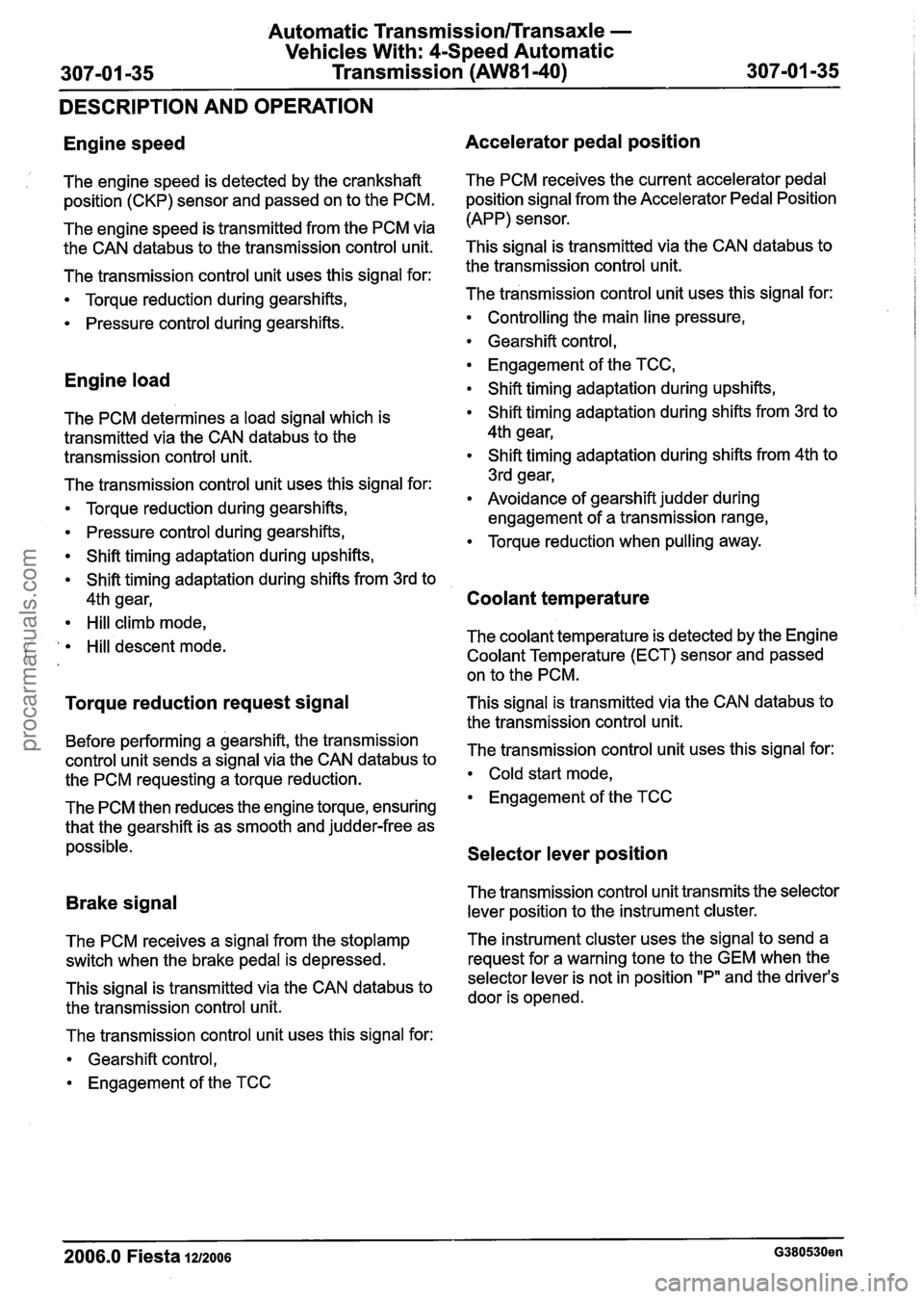
Automatic Transmission/Transaxle -
Vehicles With: 4Speed Automatic
307-01 -35 Transmission (AW81-40) 307-01 -35
DESCRIPTION AND OPERATION
Engine speed
1 The engine speed is detected by the crankshaft
position (CKP) sensor and passed on to the PCM.
The engine speed is transmitted from the PCM via
the CAN
databus to the transmission control unit.
The transmission control unit uses this signal for:
Torque reduction during gearshifts,
Pressure control during gearshifts.
Engine load
The PCM determines a load signal which is
transmitted via the CAN
databus to the
transmission control unit.
The transmission control unit uses this signal for:
Torque reduction during gearshifts,
Pressure control during gearshifts,
Shift timing adaptation during upshifts,
Shift timing adaptation during shifts from 3rd to
4th gear,
Hill climb mode,
( ' Hill descent mode. ' ,
Torque reduction request signal
Before performing a gearshift, the transmission
control unit sends a signal via the CAN
databus to
the PCM requesting a torque reduction.
The PCM then reduces the engine torque, ensuring
that the gearshift is as smooth and judder-free as
possible.
Brake signal
The PCM receives a signal from the stoplamp
switch when the brake pedal is depressed.
This signal is transmitted via the CAN
databus to
the transmission control unit.
The transmission control unit uses this signal for:
Gearshift control,
Engagement of the TCC
Accelerator pedal position
The PCM receives the current accelerator pedal
position signal from the Accelerator Pedal Position
(APP) sensor.
This signal is transmitted via the CAN
databus to
the transmission control unit.
The transmission control unit uses this signal for:
Controlling the main line pressure,
Gearshift control,
Engagement of the TCC,
Shift timing adaptation during upshifts,
Shift timing adaptation during shifts from 3rd to
4th gear,
Shift timing adaptation during shifts from 4th to
3rd gear,
Avoidance of gearshift judder during
engagement of a transmission range,
Torque reduction when pulling away.
Coolant temperature
The coolant temperature is detected by the Engine
Coolant Temperature (ECT) sensor and passed
on to the PCM.
This signal is transmitted via the CAN
databus to
the transmission control unit.
The transmission control unit uses this signal for:
Cold start mode,
Engagement of the TCC
Selector lever position
The transmission control unit transmits the selector
lever position to the instrument cluster.
The instrument cluster uses the signal to send a
request for a warning tone to the GEM when the
selector lever is not in position "P" and the driver's
door is opened.
-
2006.0 Fiesta 1212006 G380530en
procarmanuals.com
Page 997 of 1226
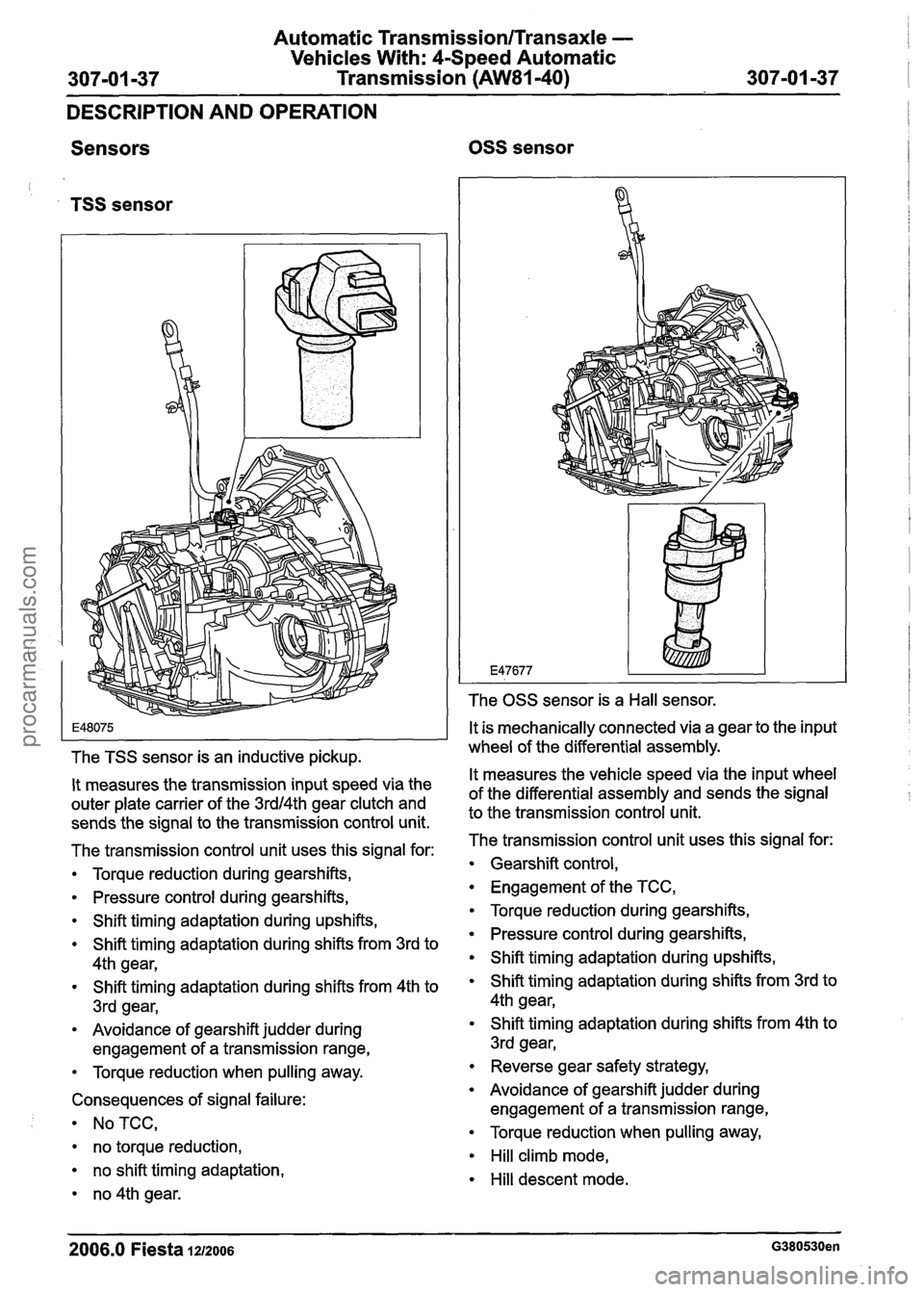
Automatic TransmissionlTransaxle -
Vehicles With: 4-Speed Automatic
307-01 -37 Transmission
(AW81-40) 307-01 -37
DESCRIPTION AND OPERATION
Sensors
OSS sensor
TSS sensor
The TSS sensor is an inductive pickup.
It measures the transmission input speed via the
outer plate carrier of the
3rdl4th gear clutch and
sends the signal to the transmission control unit.
The transmission control unit uses this signal for:
Torque reduction during gearshifts,
Pressure control during gearshifts,
Shift timing adaptation during upshifts,
Shift timing adaptation during shifts from 3rd to
4th gear,
Shift timing adaptation during shifts from 4th to
3rd gear,
Avoidance of gearshift judder during
engagement of a transmission range,
Torque reduction when pulling away.
Consequences of signal failure:
No TCC,
no torque reduction,
no shift timing adaptation,
no 4th gear. The
OSS sensor is a Hall sensor.
It is mechanically connected via a gear to the input
wheel of the differential assembly.
It measures the vehicle speed via the input wheel
of the differential assembly and sends the signal
to the transmission control unit.
The transmission control unit uses this signal for:
Gearshift control,
Engagement of the TCC,
Torque reduction during gearshifts,
Pressure control during gearshifts,
Shift timing adaptation during upshifts,
Shift timing adaptation during shifts from 3rd to
4th gear,
Shift timing adaptation during shifts from 4th to
3rd gear,
Reverse gear safety strategy,
Avoidance of gearshift judder during
engagement of a transmission range,
Torque reduction when pulling away,
Hill climb mode,
Hill descent mode.
2006.0 Fiesta 1212006 G380530en
procarmanuals.com
Page 998 of 1226
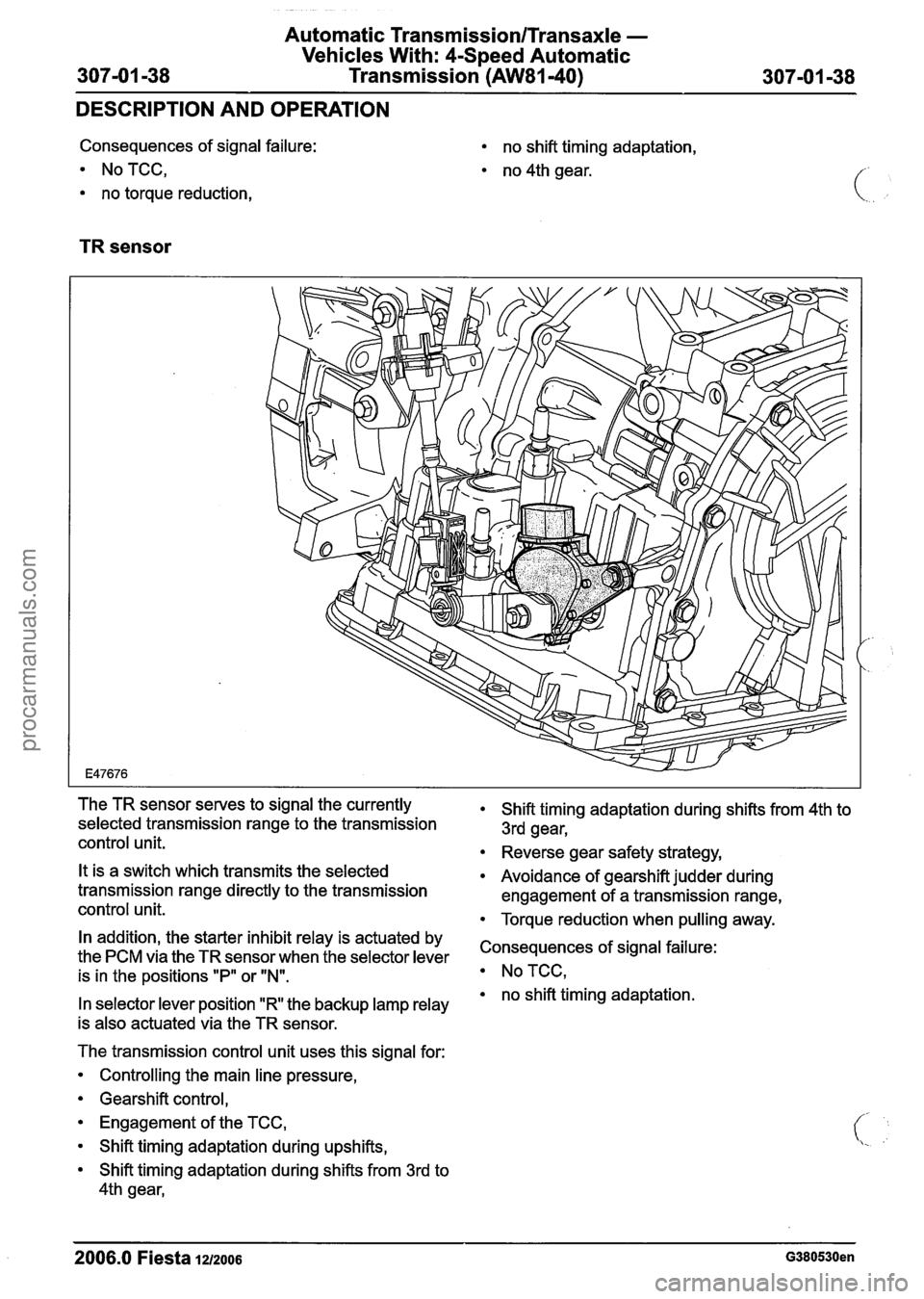
Automatic Transmission/Transaxle -
Vehicles With: 4Speed Automatic
307-01 -38 Transmission (AW81-40) 307-01 -38
DESCRIPTION AND OPERATION
Consequences of signal failure:
NoTCC,
no torque reduction, no shift timing adaptation,
no 4th
gear.
TR sensor
The TR sensor serves to signal the currently
selected transmission range to the transmission
control unit.
It is a switch which transmits the selected
transmission range directly to the transmission
control unit.
In addition, the starter inhibit relay is actuated by
the PCM via the TR sensor when the selector lever
is in the positions "P" or
N.
In selector lever position "R the backup lamp relay
is also actuated via the TR sensor.
The transmission control unit uses this signal for:
Controlling the main line pressure,
Gearshift control,
Engagement of the TCC,
Shift timing adaptation during upshifts,
Shift timing adaptation during shifts from 3rd to
4th gear,
Shift timing adaptation during shifts from 4th to
3rd gear,
Reverse gear safety strategy,
Avoidance of gearshift judder during
engagement of a transmission range,
Torque reduction when pulling away.
Consequences of signal failure:
NoTCC,
no shift timing adaptation.
2006.0 Fiesta 1212006 G380530en
procarmanuals.com
Page 999 of 1226
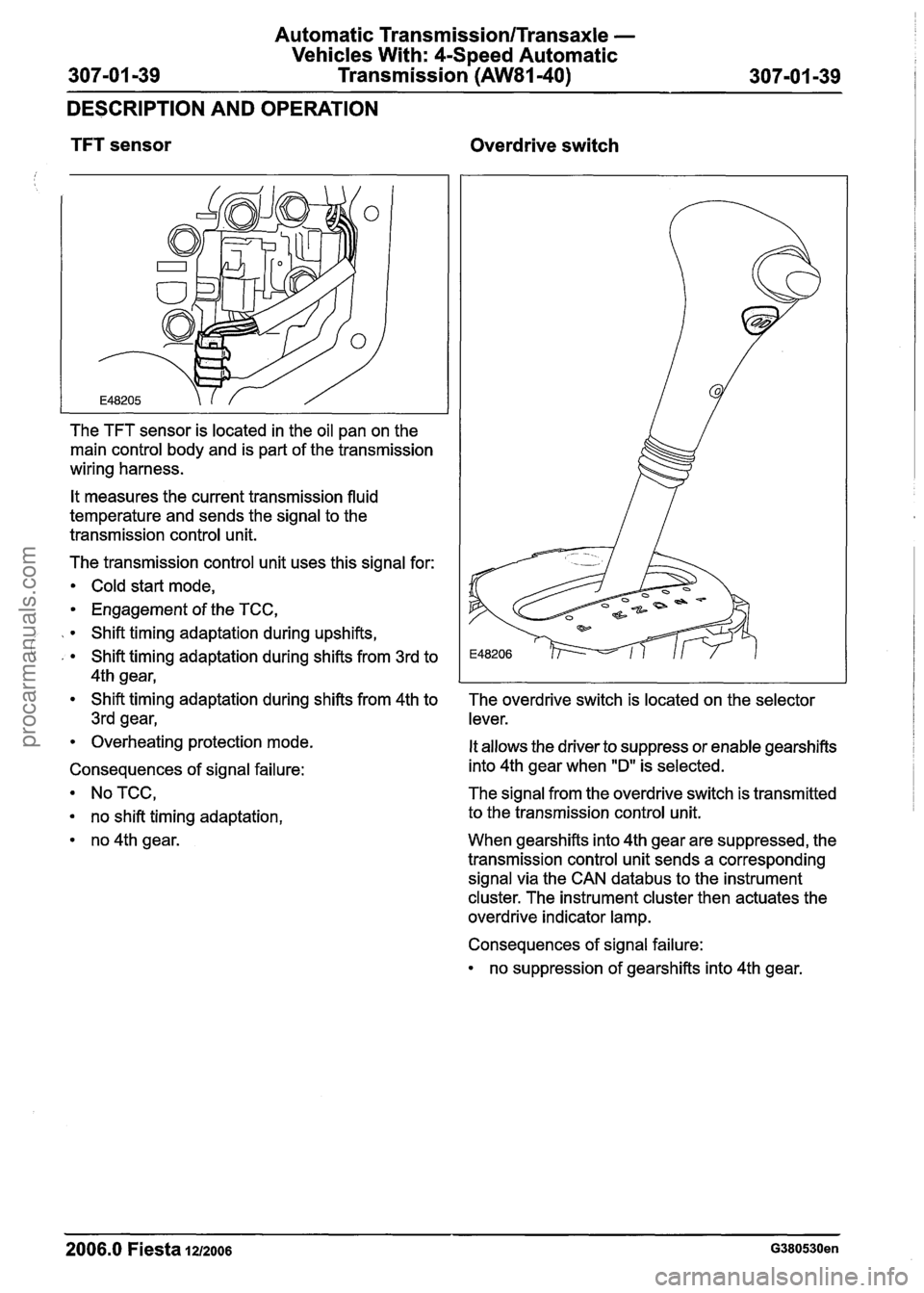
Automatic Transmission/Transaxle -
Vehicles With: 4-Speed Automatic
307-01 -39 Transmission (AW81-40) 307-01 -39
DESCRIPTION AND OPERATION
TFT sensor Overdrive switch
The TFT sensor is located in the oil pan on the
main control body and is part of the transmission
wiring harness.
It measures the current transmission fluid
temperature and sends the signal to the
transmission control unit.
The transmission control unit uses this signal for:
Cold start mode,
Engagement of the TCC,
Shift timing adaptation during upshifts,
' , Shift timing adaptation during shifts from 3rd to
4th gear,
Shift timing adaptation during shifts from 4th to
3rd gear,
Overheating protection mode.
Consequences of signal failure:
NoTCC,
no shift timing adaptation,
no 4th gear. The overdrive switch
is located on the selector
lever.
It allows the driver to suppress or enable gearshifts
into 4th gear when
"D" is selected.
The signal from the overdrive switch is transmitted
to the transmission control unit.
When gearshifts into 4th gear are suppressed, the
transmission control unit sends a corresponding
signal via the CAN
databus to the instrument
cluster. The instrument cluster then actuates the
overdrive indicator lamp.
Consequences of signal failure:
no suppression of gearshifts into 4th gear.
2006.0 Fiesta 1212006 G380530en
procarmanuals.com
Page 1002 of 1226
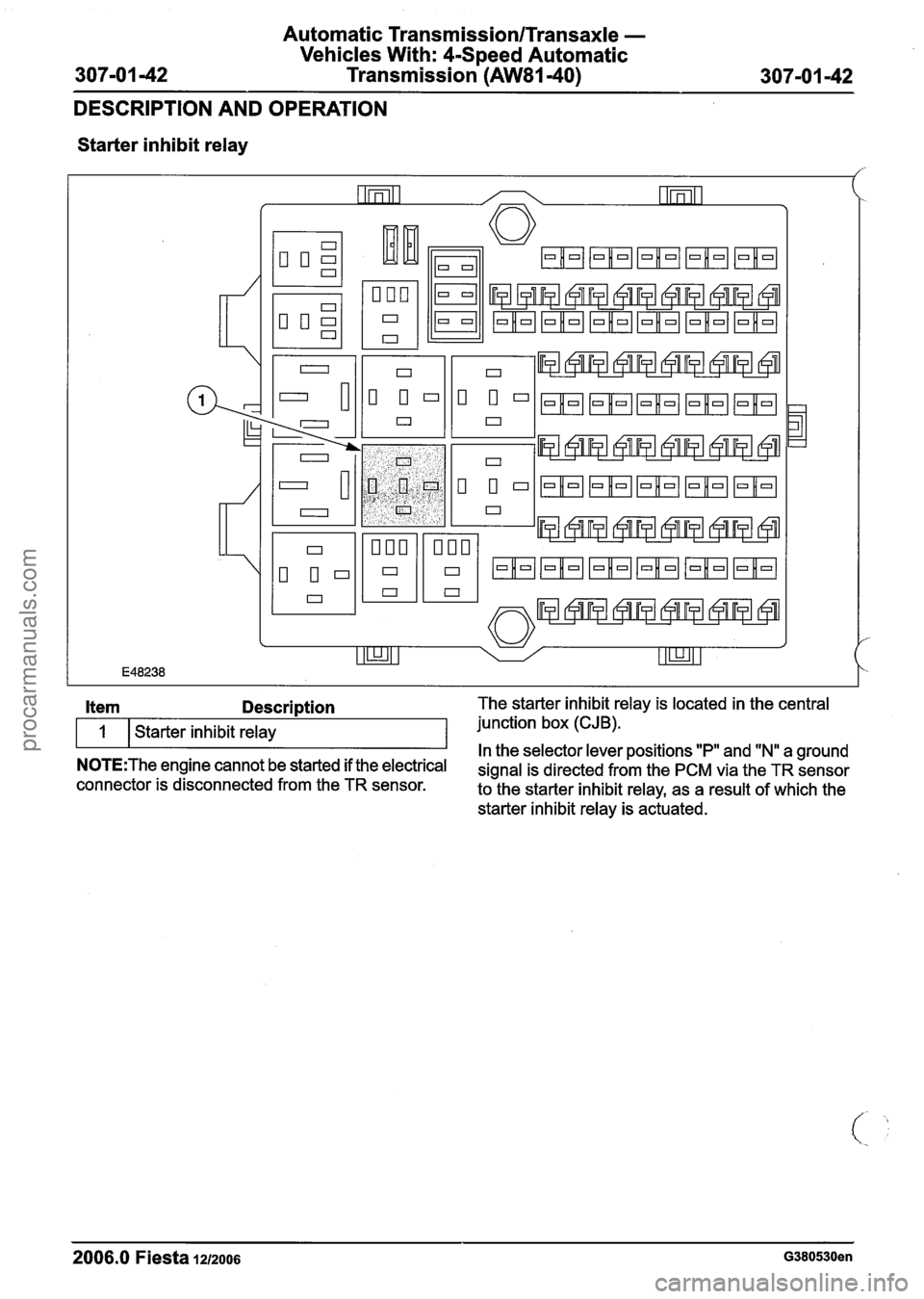
Automatic Transmission/Transaxle -
Vehicles With: 4-Speed Automatic
Transmission
(AW81-40)
DESCRIPTION AND OPERATION
Starter inhibit relay
2006.0 Fiesta
12/2006 G380530en
Item Description The starter inhibit relay is located in the central
1 Starter inhibit relay junction
box (CJB).
In the selector lever positions "P" and "Nu a ground N0TE:The engine cannot be started if the electrical signal is directed from the PCM via the TR sensor connector is disconnected from the TR sensor.
to the starter inhibit relay, as a result of which the
starter inhibit relay is actuated.
procarmanuals.com
Page 1003 of 1226
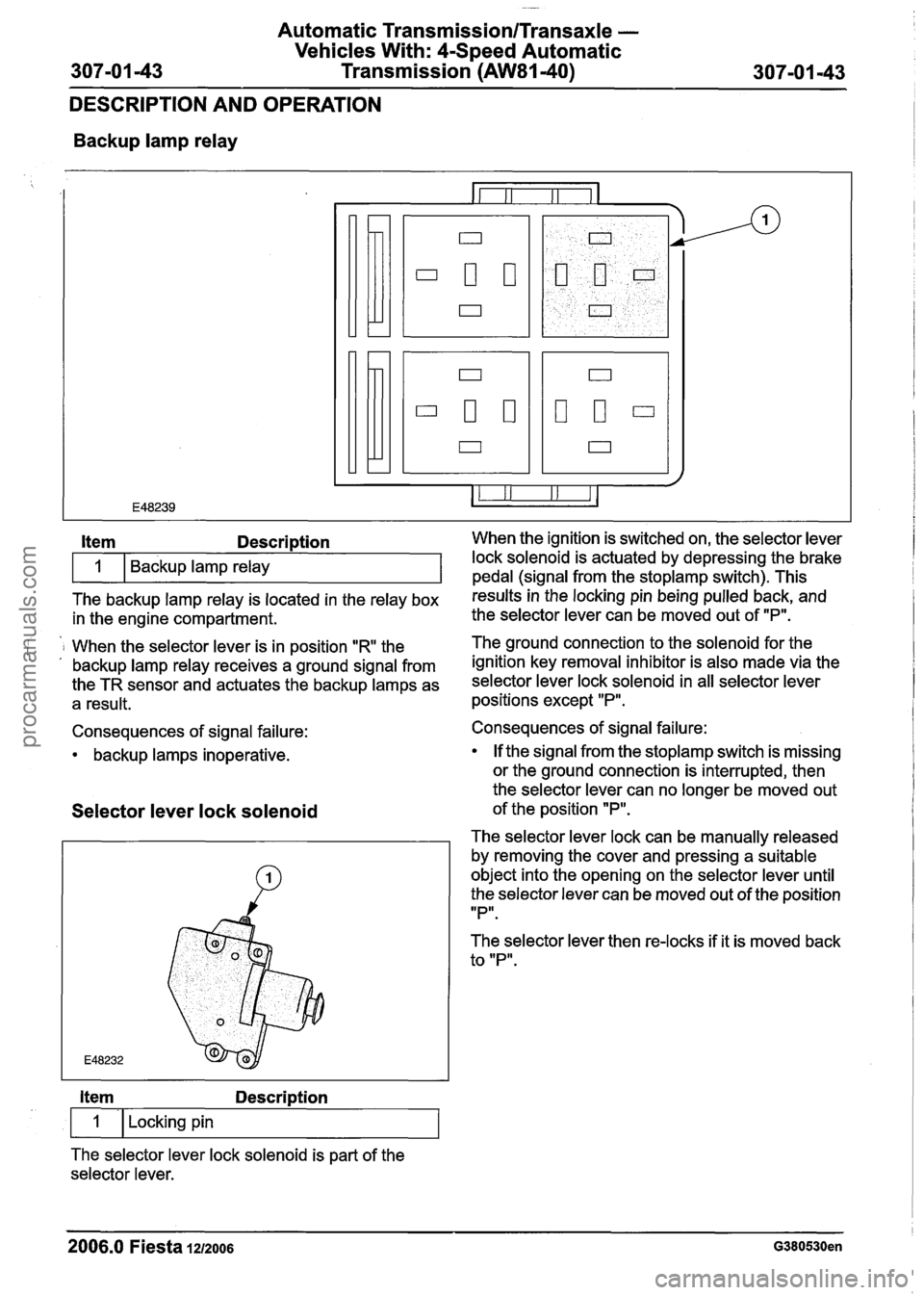
Automatic Transmission/Transaxle -
Vehicles With: 4-Speed Automatic
307-01 -43 Transmission (AW81-40) 307-01 -43
DESCRIPTION AND OPERATION
Backup lamp relay
The backup lamp relay is located in the relay box results inthe locking pin being pulled back, and
in the engine compartment. the
selector lever can be moved out of "P".
Item Description When the ignition is switched on, the selector lever
i 1 When the selector lever is in position "R the The ground connection to the solenoid for
the . , backup lamp relay receives a ground signal from ignition key removal inhibitor is also made via the
the TR sensor and actuates the backup lamps as selector lever lock solenoid in all selector lever
a result. positions except "P".
1
Consequences of signal failure:
backup lamps inoperative. Backup lamp relay
Selector
lever lock solenoid
lock solenoid is actuated by depressing the brake
pedal (sianal from the stoplamp switch). This
Item Description
1 I Locking pin
The selector lever lock solenoid is part of the
selector lever. Consequences of signal failure:
If the signal from the
stoplamp switch is missing
or the ground connection is interrupted, then
the selector lever can no longer be moved out
of the position
"P".
The selector lever lock can be manually released
by removing the cover and pressing a suitable
object into the opening on the selector lever until
the selector lever can be moved out of the position
IIPlr.
The selector lever then re-locks if it is moved back
to "P".
2006.0 Fiesta 1212006 G380530en
procarmanuals.com
Page 1005 of 1226
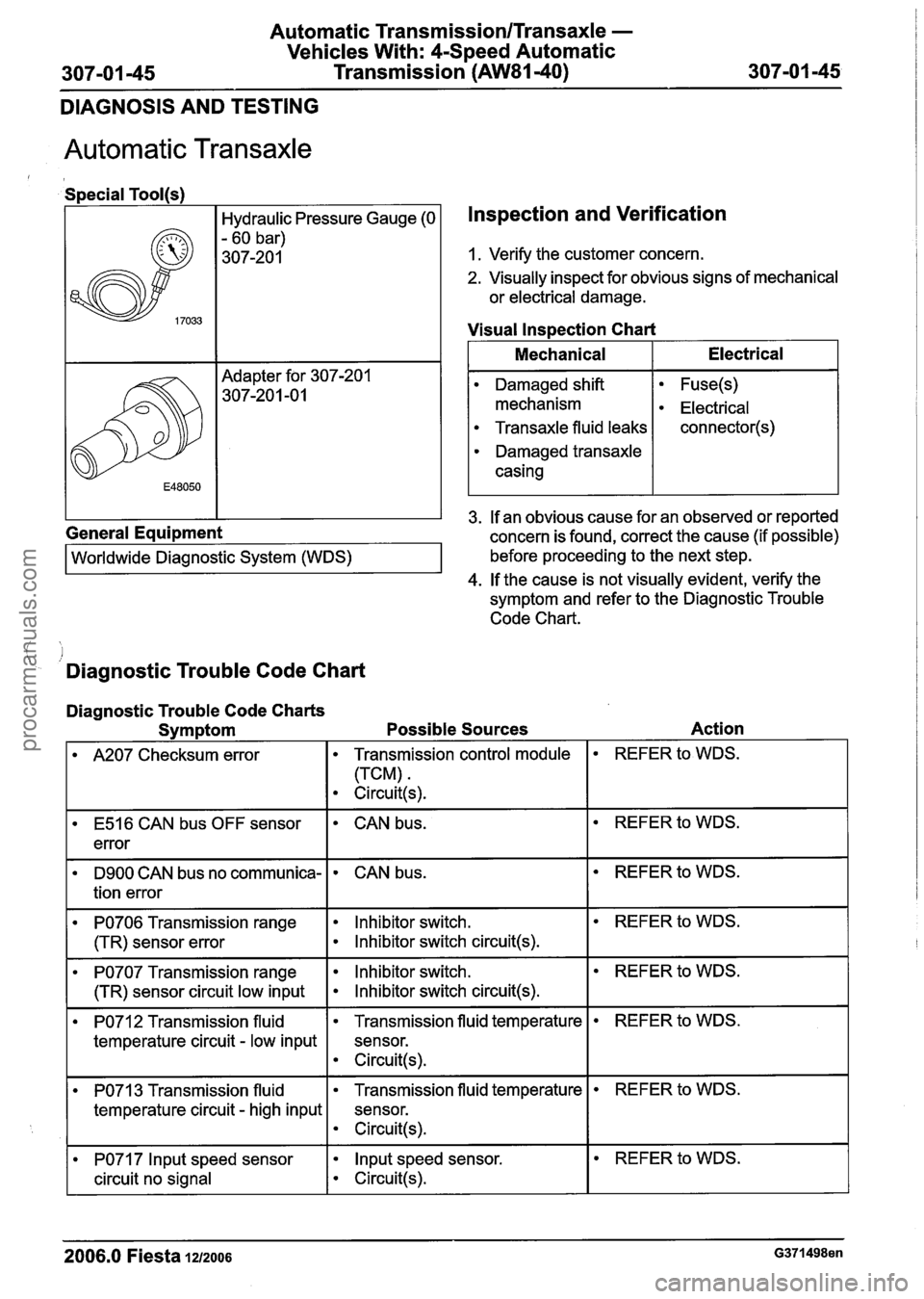
Automatic Transmission/Transaxle -
Vehicles With: 4-Speed Automatic Transmission
(AW81-40)
DIAGNOSIS AND TESTING
Automatic Transaxle
Special Tool(s)
Hydraulic Pressure Gauge (0
- 60 bar)
307-20 1
General Equipment Worldwide
~ia~noitic System (WDS)
Inspection and Verification
1. Verify the customer concern.
2. Visually inspect for obvious signs of mechanical
or electrical damage.
Visual
lns~ection Chart
I Mechanical I Electrical I
3. If an obvious cause for an observed or reported
concern is found, correct the cause (if possible)
before proceeding to the next step.
4. If the cause is not visually evident, verify the
symptom and refer to the Diagnostic Trouble
Code Chart.
Damaged shift
mechanism
Transaxle fluid leaks
Damaged transaxle
casing
.I
- Diagnostic Trouble Code Chart
Fuse(s)
Electrical
connector(s)
Diagnostic Trouble Code Charts
Symptom Possible Sources Action
I A207 Checksum error I Transmission control module I REFER to WDS.
E516 CAN bus OFF sensor
error CAN bus.
D9OO CAN bus no communica-
tion error
PO706 Transmission range
(TR) sensor error
PO707 Transmission range
(TR) sensor circuit low input
CAN bus.
Inhibitor switch.
Inhibitor switch circuit(s).
lnhibitor switch.
lnhibitor switch circuit(s).
PO712 Transmission fluid
temperature circuit
- low input
REFER to WDS.
REFER to WDS.
3 Transmission fluid
temperature circuit
- high input
2006.0 Fiesta 1212006 G371498en
Transmission fluid temperature
sensor.
Circuit(s).
PO71 7 lnput speed sensor
circuit no signal
REFER to WDS.
Transmission fluid temperature
sensor.
e Circuit(s).
lnput speed sensor.
Circuit(s).
REFER to WDS.
procarmanuals.com
Page 1006 of 1226
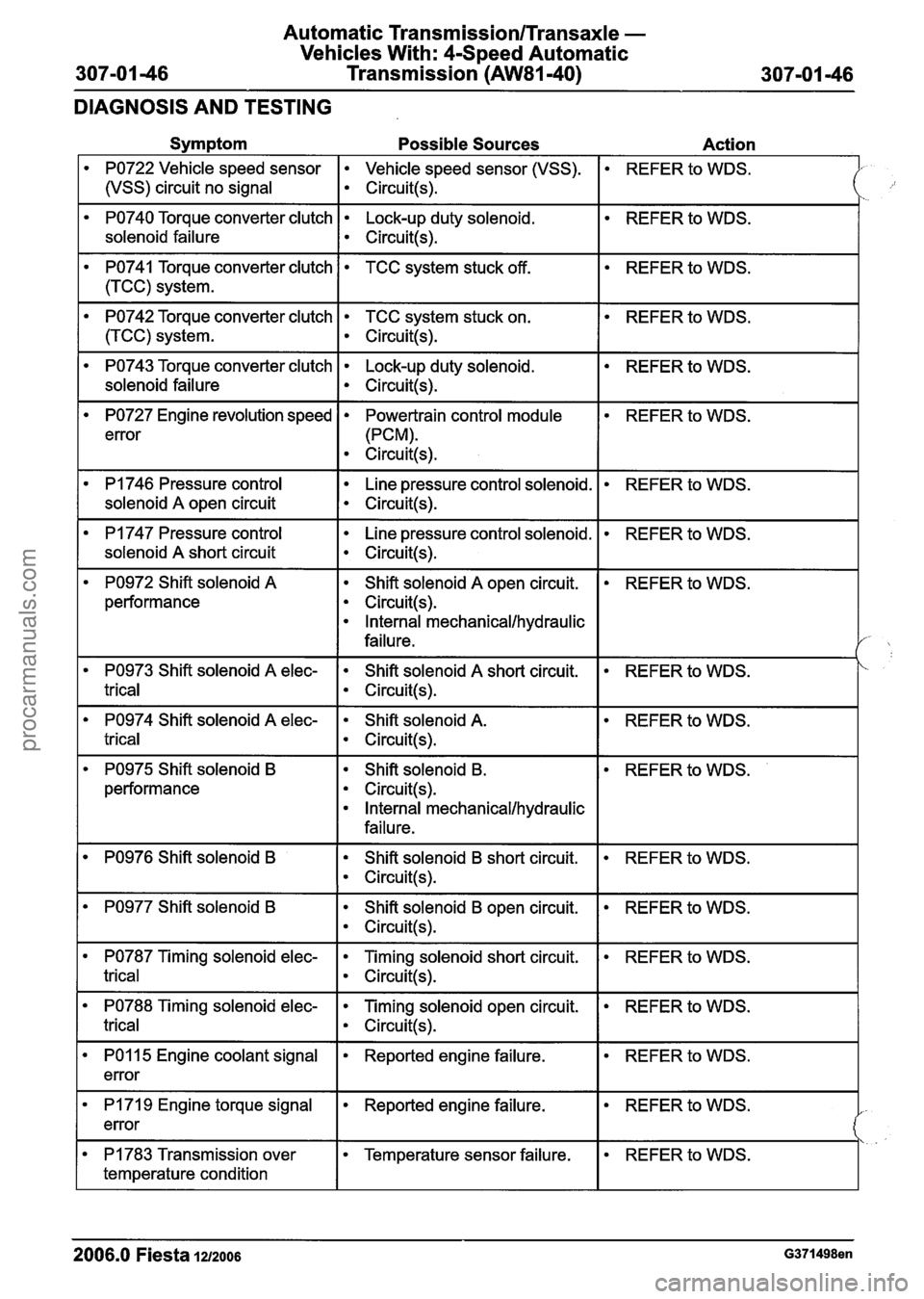
Automatic Transmission/Transaxle -
Vehicles With: 4Speed Automatic
307-01 -46 Transmission
(AW81-40) 307101 -46
DIAGNOSIS AND TESTING
Symptom Possible Sources Action
PO722 Vehicle speed sensor Vehicle speed sensor (VSS).
1 (vSS) circuit no signal I circuit(+
REFER to WDS.
PO740 Torque converter clutch Lock-up duty solenoid.
solenoid failure
I ~ircuit(s).
REFER to WDS.
REFER to WDS.
PO741 Torque converter clutch
1 (TCC) system.
PO742 Torque converter clutch TCC system stuck on.
I circuit(s).
TCC system stuck off.
REFER to WDS.
PO743 Torque converter clutch Lock-up duty solenoid.
solenoid failure
I circuit(s).
REFER to WDS.
REFER to WDS.
PO727 Engine revolution speed
error
PI 746 Pressure control
I solenoid A open circuit
Powertrain control module
(PCM).
Circuit(s).
I
Line pressure control solenoid.
Circuit(s).
REFER to WDS.
PI 747 Pressure control
solenoid
A short circuit
Line pressure control solenoid.
Circuit(s).
REFER to WDS.
PO972 Shift solenoid A
performance Shift solenoid
A open
circuit.
Circuit(s).
Internal mechanical/hydraulic
failure.
REFER to WDS.
REFER to WDS.
PO974 Shift solenoid A elec- Shift solenoid A.
trical I circuit(!+
PO973 Shift solenoid A elec-
trical
REFER to WDS. Shift solenoid A short circuit.
Circuit(s).
PO975 Shift solenoid B
performance Shift solenoid
B.
Circuit(s).
Internal mechanical/hydraulic
failure.
REFER
to WDS.
PO976 Shift solenoid B Shift solenoid B short circuit.
Circuit(s).
REFER to WDS.
PO977 Shift solenoid B Shift solenoid B open circuit.
Circuit(s).
REFER to WDS.
PO787 Timing solenoid elec- Timing solenoid short circuit.
trical I circuit(s).
REFER to WDS.
REFER to WDS. PO788 Timing solenoid elec-
trical
-- - -
Timing solenoid open circuit.
Circuit(s).
REFER to WDS. PO1 15 Engine coolant signal
error Reported engine failure.
REFER to WDS. I PI 71 9 Engine torque signal
error Reported engine failure.
REFER to WDS. PI 783 Transmission over
temperature condition
2006.0 Fiesta 12/2006 G371498en
Temperature sensor failure.
procarmanuals.com
Page 1007 of 1226
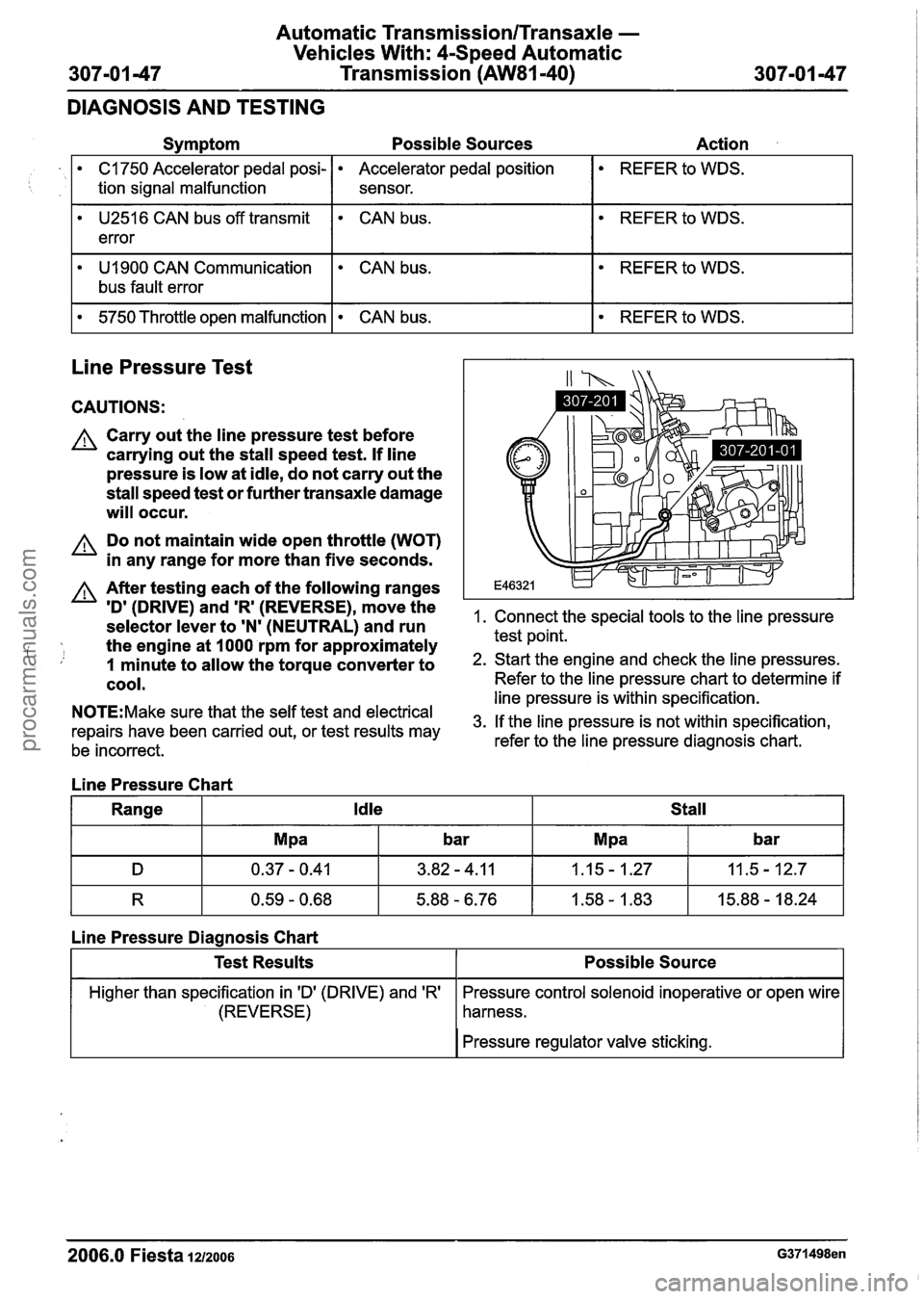
Automatic Transmission/Transaxle -
Vehicles With: 4-Speed Automatic
307-01 47 Transmission (AW81-40) 307-01 -47
DIAGNOSIS AND TESTING
Symptom Possible Sources Action
'
U2516 CAN bus off transmit
error
I 5750 Throttle open malfunction 1 . CAN bus. 1. REFER to WDS. I
CAN bus.
U1900 CAN Communication
bus fault error
Line Pressure Test
C1750 Accelerator pedal posi-
tion signal malfunction
. CAN bus.
CAUTIONS:
A Carry out the line pressure test before
carrying out the stall speed test.
If line
pressure is low at idle, do not carry out the
stall speed test or further transaxle damage
will occur.
Accelerator pedal position
sensor.
A Do not maintain wide open throttle (WOT)
in any range for more than five seconds.
REFER to WDS.
A After testing each of the following ranges
ID' (DRIVE) and 'R' (REVERSE)r move the 1. Connect the special tools to the line pressure selector lever to 'N' (NEUTRAL) and run
the engine at
I000 rpm for approximately test point.
i, 1 minute to allow the torque converter to 2. Start the engine and check the line pressures.
cool. Refer to the line pressure chart to determine if -- --- line pressure is within specification. N0TE:Make sure that the self test and electrical 3m If the line pressure is not within specification, repairs have been carried out, or test results may
be incorrect. refer to the
line pressure diagnosis chart.
Line Pressure Chart
Range
Idle Stall
R 0.59 - 0.68 5.88 - 6.76 1.58 - 1.83 15.88 - 18.24
Line Pressure Diagnosis Chart
I I Pressure regulator valve sticking. I
Test Results
Higher than specification in 'D' (DRIVE) and 'R'
(REVERSE)
2006.0 Fiesta 1212006 G371498en
Possible Source
Pressure control solenoid inoperative or open wire
harness.
procarmanuals.com
Page 1015 of 1226
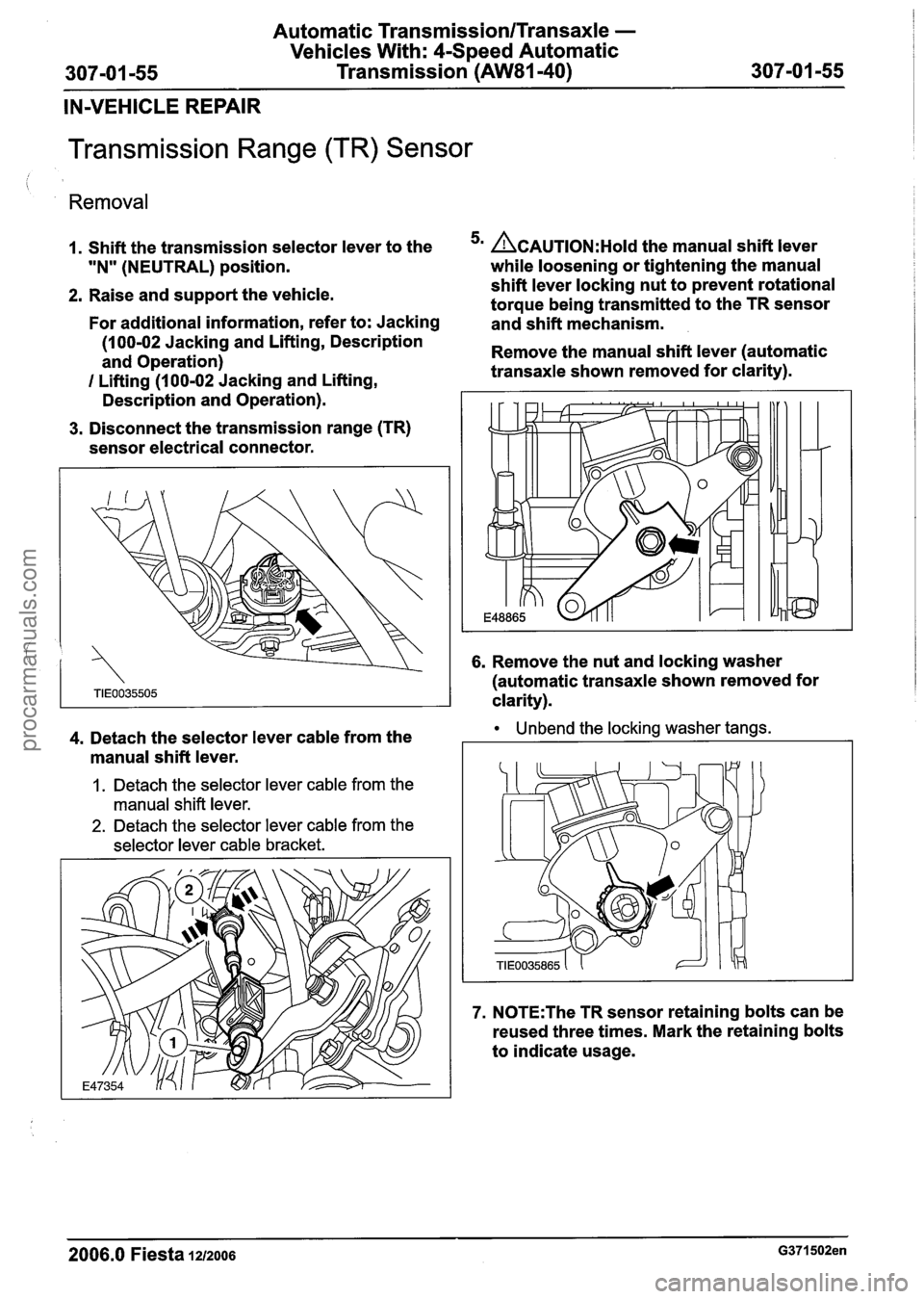
Automatic Transmission/Transaxle -
Vehicles With: 4-Speed Automatic
307101 -55 Transmission (AW81-40) 307-01 -55
IN-VEHICLE REPAIR
Transmission Range (TR) Sensor
Removal
1. Shift the transmission selector lever to the ACAUTION:H~I~ the manual shift lever
"N" (NEUTRAL) position. while loosening
or tightening the manual - -
2. Raise and support the vehicle. shift
lever locking nut to prevent rotational
torque being transmitted to the TR sensor
For additional information, refer to: Jacking
and shift mechanism.
(1
00-02 Jacking and Lifting, Description
and Operation) Remove
the manual shift lever (automatic
I Lifting (1 00-02 Jacking and Lifting, transaxle
shown removed for clarity).
Description and Operation).
3. Disconnect the transmission range (TR)
sensor electrical connector.
6. Remove the nut and locking washer
(automatic transaxle shown removed for
clarity).
4. Detach the selector lever cable from the Unbend the locking washer tangs.
manual shift lever.
1. Detach the selector lever cable from the
manual shift lever.
2. Detach the selector lever cable from the
selector lever cable bracket.
7. N0TE:The TR sensor retaining bolts can be
reused three times. Mark the retaining bolts
to indicate usage.
2006.0 Fiesta 1212006 G371502en
procarmanuals.com